The Belfast Blitz
The Easter Tuesday Raid
The Dockside raid demonstrated that German bombers could hit Belfast. Moreover, a radio broadcast from Germany by William Joyce, better known as Lord Haw-Haw, predicted that there would be 'Easter Eggs for Belfast'. The threat was clear to politicians, demonstrated by a letter from the Prime Minister for Northern Ireland, John Andrews, in a letter to Churchill at the end of March, where he opined that Germany would have difficulty attacking Belfast unless aided by moonlight, adding 'The period of the next moon from, say 7th to the 16th April, may well bring our turn'.
On Good Friday, 11 April 1941, a single Heinkel HE 111 passed over the city just after 1:00pm, drawing fire from the heavy anti-aircraft guns, but they had little effect as the aircraft was flying at over 20,000 feet. Four days later, another German aircraft passed over the city, but no one below was aware that Belfast was the Luftwaffe's primary target for that night.
The weather was dull and overcast, but civil defence and the military were placed on alert. At 10:40pm, a red alert was accompanied by the wail of sirens across the city. An hour later, the drone of approaching aircraft was heard across the city. The first wave came from the south over the Irish sea, passing east of Belfast before turning to begin the attack from the northwest along Belfast Lough. A three-quarter moon lit the scene, but the weather was poor, with low cloud cover. Moreover, 18 smoke generators were ignited to obscure the factories, stores, and docks in the harbour estate.
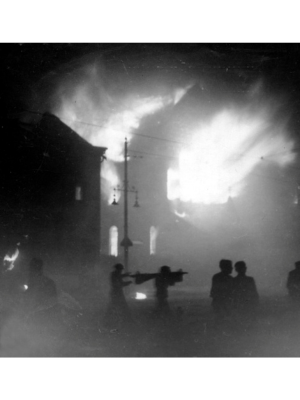
Possibly one-third of the aircraft designated to attack Belfast failed to find the city, but around 180 took part in the attack. The first aircraft to arrive were pathfinder units, which used brilliant magnesium flares and incendiaries to mark the target areas for following waves of aircraft. Hundreds of flares suspended on parachutes descended, mainly over the densely packed houses in the north of the city. Many noted how the city was bathed in an eerie white light ‘as bright as day’. However, the German pathfinder units missed their targets, marking the area west of the harbour estate, and it was here that the majority of the bombs fell. Bombing techniques relied on dead reckoning and visual bombsights as the German aircraft were beyond the range of their radio navigation beacons. Consequently, this combined with poor weather resulted in most bombers missing their targets.
The mis-dropped targeting incendiaries set blazes that guided the following bombers with devastating consequences for those living in the north and west of the city. The initial incendiaries were followed by high explosives, as 250kg, 500kg, and 1000kg bombs rained down. By 2:00am, the messages arriving in the civil defence control centres painted a picture of unprecedented devastation. In Hogarth Street, 70 people were killed and 40 houses demolished. The communal shelter in Atlantic Avenue was destroyed by a direct hit, killing 38. A shelter in Percy Street was also hit with the loss of possibly 40 lives.
Many people took cover under stairs or in 'coal holes', with accounts of families sheltering under kitchen tables rather than moving to the communal shelters which, after years of inactivity, had become public toilets or places of anti-social activity, causing some to have locked doors fitted. Without any real concept of the nature of aerial bombing or how to behave under attack, reports noted people fleeing their houses only to be cut down in the streets by blasts and flying debris.
W&M211 Interviewee Eithné O'Connor was in the Atlantic Avenue Shelter which collapsed during the Easter Tuesday Raid:
'Then we all got down on the floor and we're laying on the floor and I felt this thing on my shoulders. There was this thing pressing me down, because this rattling, banging, and all this terrible noise was going on outside. And I didn't know where my mummy was. I didn't know where my sister was, like they weren't beside me on the floor... and we heard daddy shout, "Meg! Mary! Eithné!” And we heard him calling us. I crawled on the ground. I crawled and I had trouble trying to crawl around, this thing on my shoulders was pressing me down, but I crawled and I crawled and I crawled. And eventually I got crawling out'.
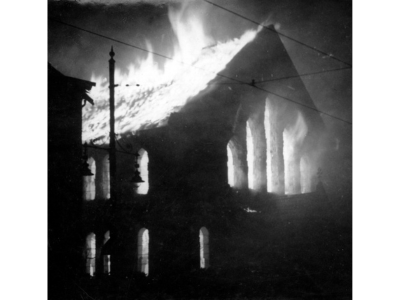
The raid intensified after 1:00am, with soldiers stationed in Bangor, Co. Down, noting how the 'flashes became more frequent and the explosions more violent'. Defensive fire from heavy anti-aircraft batteries was limited, firing approximately 1,700 shells, German pilots considered the fire to be light and poorly directed. At 1:55am, a parachute mine hit the central telephone exchange, severing the telephone lines to the batteries. Without targeting information, the batteries had to cease fire.
Throughout the raid, approximately 180 aircraft attacked the city, dropping 203 tons of high explosives, of which 79 were 1,000kg parachute mines. A further 29,000 incendiaries ignited widespread fires. Some damage was caused to the Short & Harland aircraft factory and the shipyard, but most of the destruction landed on the civilian population. A six-storey wall at York Street linen mill collapsed on Vere Street and Sussex Street, killing almost 40, and in Ohio Street and Heather Street, bombs killed over 60 of the residents, many of whom remained in their homes rather than seek out a public shelter. At 4 Ballynure Street, 14 people were killed in a single house, 8 of whom were from the same family.
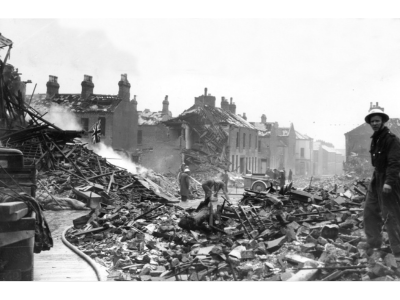
The ARP and rescue services worked throughout the raid, getting people to shelters and rescuing those trapped in their destroyed homes, but the rescue parties and fire services were overwhelmed by the scale of the devastation. Fire services were gathered in Britain to aid the hard-pressed emergency services in Belfast, but a call was also made to Éire (which was ostensibly neutral during the war) requesting assistance. This was approved by Éamon De Valera, the Irish Taoiseach, and 75 firemen on 13 tenders drove north to provide much-needed assistance.
Belfast, while bearing the brunt of the attack, was not the only place hit by German bombs. In Bangor, 14 bombs landed, killing 5 people. Bombs and incendiaries fell across the Ards, and Scrabo Hill was ablaze. At Newtownards airfield, the barrack huts housing guard detachments from the 70th Battalion, Royal Inniskilling Fusiliers were hit, killing 10 and wounding another 16 soldiers. Far to the north, a lone German aircraft dropped 2 parachute mines on Derry/Londonderry, killing 13, including 6 from one family.
W&M257 Interviewee Brian Lyttle was living in Bangor at the time:
'You could hear the steady drone of the German aircraft coming over and as I say the aircraft guns firing away. And then perhaps 20 minutes after that, you could hear the dull thud of the bombs falling on Belfast. And at that time, my father of course had to go out as an air raid warden with his tin helmet on. My mother had gathered me and my baby brother into part of the house which was not overlooked by any windows, we sort of sat, it was in the front hall actually of the house, because she knew quite well the windows could be blown in. And we were there for you know... I suppose, it was 3/4's of an hour or hour after the raid on Belfast which we had heard, you could hear the planes coming back and there were two of these high-pitched whines splitting the atmosphere. Immediately, my mother put her arms around me and my brother and hugged us tight you know, these sounds were then followed by loud explosions not far away.'
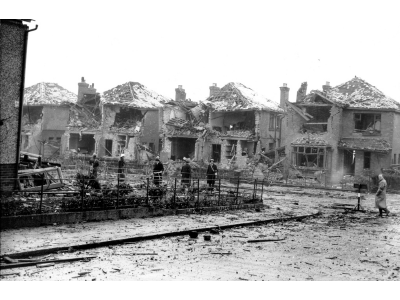
The all-clear sounded at 5:00am, and as dawn broke an hour later, the streets of north and west Belfast were scenes of carnage as brick-terraced houses provided little protection. Time-delayed bombs continued to detonate as dead and wounded flooded into the surrounding hospitals. Medical staff worked continuously to treat appalling injuries such as penetrating wounds, head injuries, crushing and amputation of limbs, and burns. The number of dead swamped the mortuary services. Therefore, temporary morgues were established at the Falls Road and Peter's Hill baths, and later at St. George's Market.
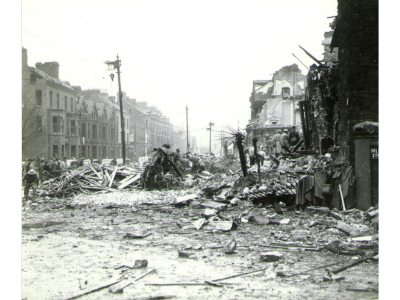
The population was profoundly shocked by the scale of the attack and the number of casualties. Initial estimates believed hundreds were dead, with reports in newspapers claiming 200 dead. In reality, almost 750 were killed or later died of their injuries, and hundreds more were seriously wounded. In the days that followed, those unidentified victims were laid out at St. George's Market as people filed past in the hope of identifying a loved one. On 21 April, those who remained unidentified (over 140) were buried in 2 mass graves at Belfast City Cemetery and Milltown Cemetery.
Beyond the massive loss of life, the raid ruined large tracts of the city, with over half the housing stock in Belfast destroyed or damaged, leaving 100,000 temporarily homeless. The raid caused near-panic in those looking to escape the city, fearful of another attack that night; up to half the population of the city self-evacuated in fear of further raids. In the weeks after the attack, tens of thousands of men, women, and children walked into the countryside with bedding each night to sleep in fields, which became known as 'ditching'. With a further estimated 70,000 evacuating into the countryside by 22 April 1941.
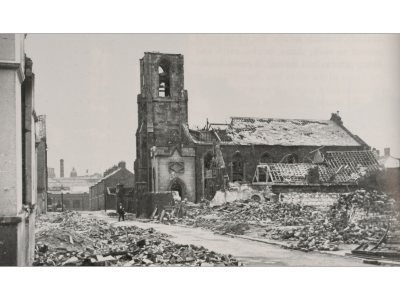
The mood of the traumatised populace was made worse by the belief that Belfast had been abandoned. To many, the Luftwaffe attacked the city without any resistance, and the lack of an effective anti-aircraft barrage and total absence after 1:55am, led many to consider the government had failed in its duty to protect the people. This was exacerbated by newspaper reports claiming Belfast could take anything the Germans could throw at it, triggering disgust in those who had suffered the brunt of the attack.
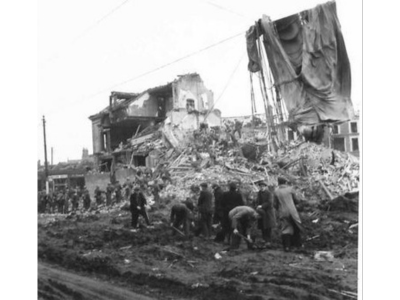
There was a breakdown in essential public services and war production was adversely affected by the mass migration of people from the city, fearful of another attack. Their concerns were well-founded as the Luftwaffe planners considered the raid to have failed in its primary goal. The damage to key war industries was minimal as the bombers had failed to seriously damage their primary targets in the docks, shipyard, and aircraft factory. Just under 3 weeks later, the German bombers returned.



